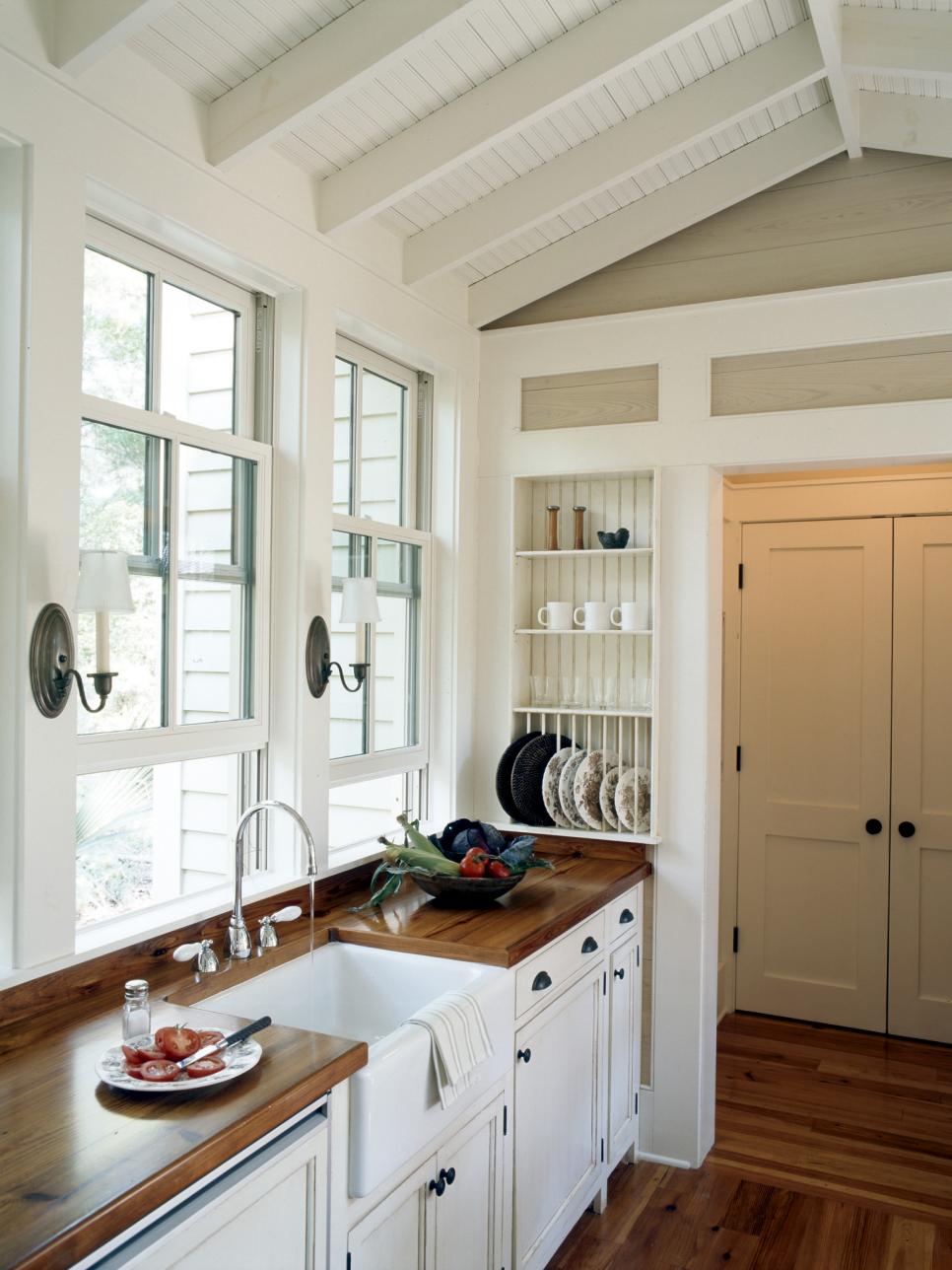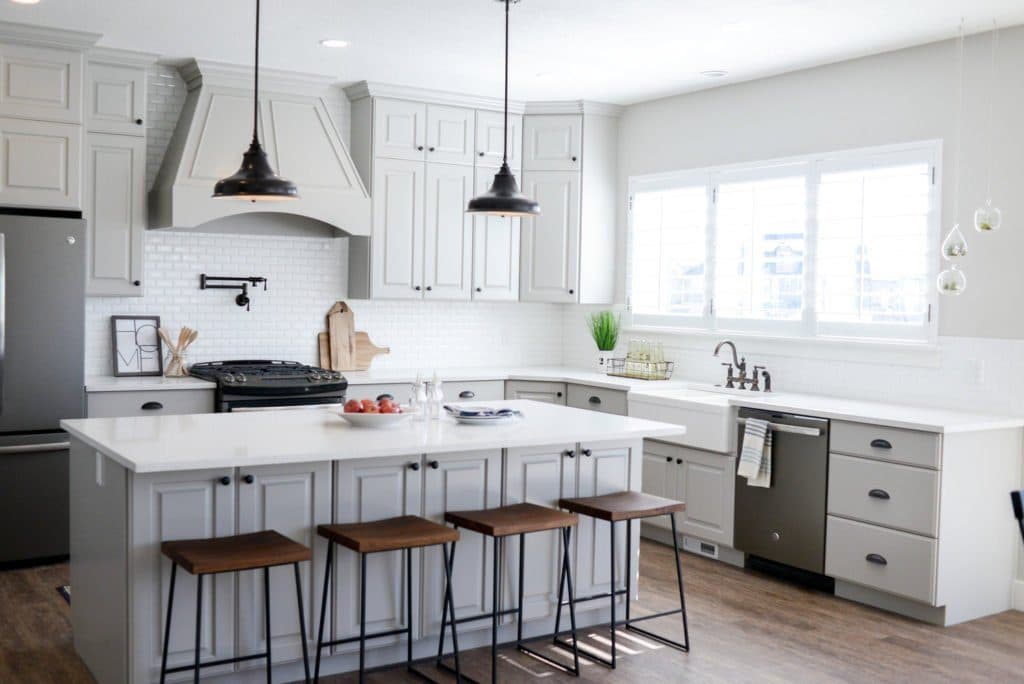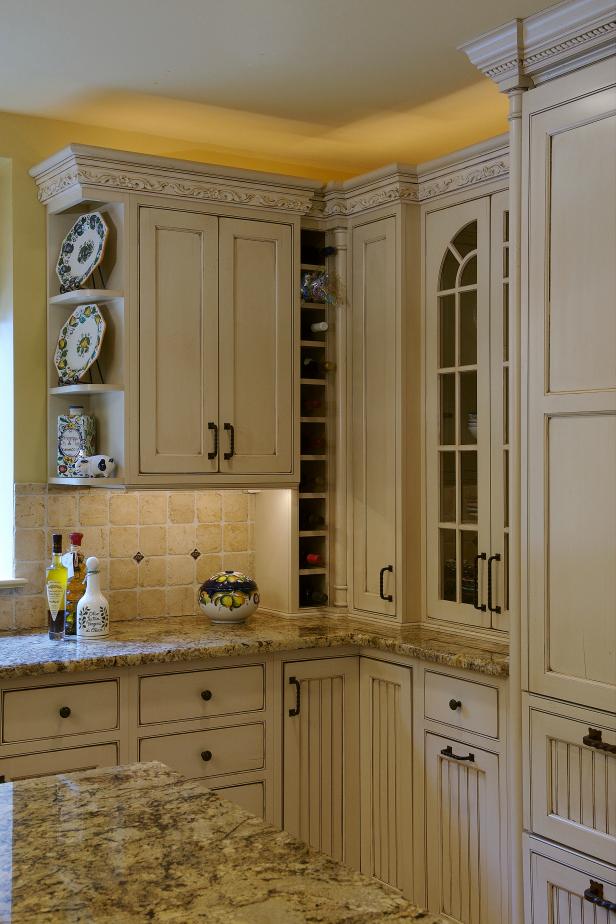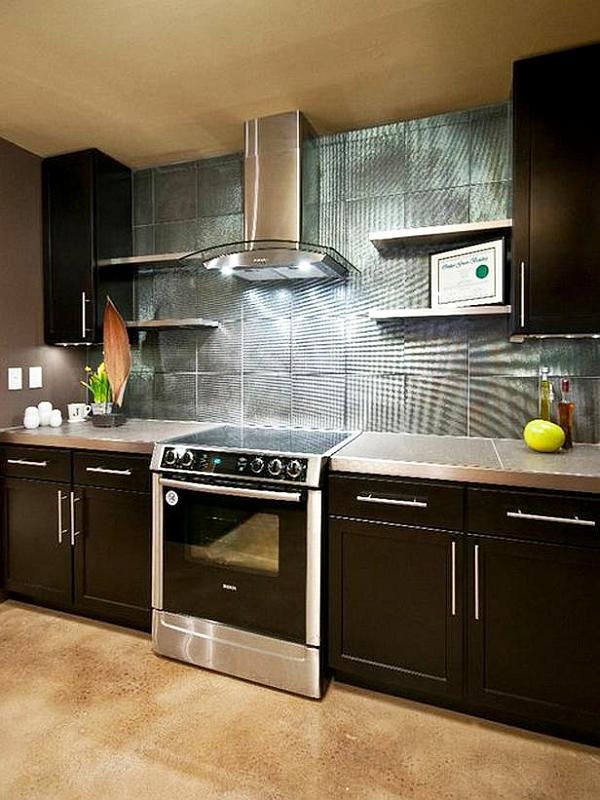Kitchen countertops are more than just functional surfaces for meal preparation; they are key design elements that define the aesthetic and usability of the kitchen. Contemporary kitchen countertops, in particular, are characterized by their sleek designs, innovative materials, and practical functionalities. Today we will talk about many aspects of contemporary kitchen countertops, from material choices and design trends to installation and maintenance.

Material Choices
Quartz
Quartz countertops have become a popular choice in contemporary kitchen design due to their durability, low maintenance, and aesthetic appeal. Engineered from natural quartz combined with resin, these countertops are available in a wide range of colors and patterns, including options that mimic natural stone like marble and granite.
One of the main advantages of quartz countertops is their non-porous surface, which makes them highly resistant to stains and bacteria. This is particularly beneficial in the kitchen, where hygiene and cleanliness are paramount. The non-porous nature also means that quartz countertops do not require sealing, unlike granite or marble.
In terms of aesthetics, quartz offers consistency in color and pattern, making it easier to achieve a uniform look. This is a significant advantage for homeowners who prefer a seamless and cohesive design. Additionally, quartz can be fabricated into various shapes and edge profiles, providing versatility in design.
However, quartz countertops are not entirely heat resistant. Placing hot pots or pans directly on the surface can cause damage, so it’s essential to use trivets or hot pads. Despite this minor drawback, quartz remains a top choice for those seeking a blend of beauty and functionality.
Installation of quartz countertops should be handled by professionals due to the material’s weight and the precision required in cutting and fitting. Proper installation ensures that the seams are nearly invisible, contributing to the sleek look that contemporary kitchens strive for.
Last, the environmental impact of quartz countertops is worth noting. Many manufacturers use recycled materials in their quartz products, making them a more sustainable option compared to other countertop materials. This eco-friendly aspect aligns well with the growing trend of sustainability in contemporary design.

Granite
Granite countertops have long been a favorite in kitchen design, and they continue to hold their ground in contemporary settings due to their natural beauty and robustness. Each slab of granite is unique, featuring a variety of colors, patterns, and veining that add character and elegance to any kitchen.
The durability of granite is one of its most significant advantages. It is highly resistant to scratches and heat, making it ideal for a busy kitchen environment. However, unlike quartz, granite is porous and requires regular sealing to prevent stains and bacteria buildup. This maintenance aspect can be a drawback for some homeowners.
In contemporary designs, granite is often used in ways that highlight its natural beauty while maintaining a clean and modern look. This can be achieved by opting for slabs with subtle veining and consistent colors. Pairing granite countertops with minimalist cabinetry and sleek hardware can create a balanced and harmonious design.
Granite’s versatility extends beyond its visual appeal. It can be used for various applications within the kitchen, including backsplashes, islands, and even integrated sinks. This flexibility allows for creative design solutions that can enhance both the functionality and aesthetics of the kitchen.
While granite is generally considered a high-end material, the cost can vary significantly depending on the type, origin, and rarity of the stone. It is advisable to visit stone yards and view the slabs in person to select the perfect piece that matches your design vision and budget.
Finally, granite countertops, when properly maintained, can last a lifetime. This longevity makes them a worthwhile investment, contributing to the overall value of your home. Their enduring appeal ensures that granite countertops remain relevant and desirable in contemporary kitchen designs.

Marble
Marble countertops exude luxury and sophistication, making them a coveted choice for contemporary kitchens. Known for their elegant veining and smooth surface, marble countertops can transform a kitchen into a high-end, stylish space. However, they come with their own set of considerations in terms of maintenance and durability.
One of the standout features of marble is its natural veining, which can range from subtle and delicate to bold and dramatic. This unique characteristic makes each marble countertop one-of-a-kind, adding a touch of individuality to your kitchen. Popular marble types include Carrara, Calacatta, and Statuario, each with distinct veining patterns and color variations.
Marble is softer than granite and quartz, making it more susceptible to scratches, stains, and etching from acidic substances. To protect the surface, it is crucial to use cutting boards, and trivets, and promptly clean up spills, especially those involving acidic foods like lemon juice or vinegar. Regular sealing can also help mitigate staining and etching.
In contemporary kitchen designs, marble is often used selectively, such as for an island countertop or a backsplash, rather than throughout the entire kitchen. This approach not only highlights the marble’s beauty but also makes it easier to manage its maintenance requirements. Pairing marble with other materials like wood or stainless steel can create a balanced and sophisticated look.
Despite its higher maintenance needs, many homeowners are willing to invest in marble for its timeless beauty and elegance. When choosing marble, it is important to consider the finish. Polished marble offers a glossy, reflective surface that enhances its luxurious appeal, while honed marble provides a matte finish that can better hide scratches and etching.
Marble countertops are often seen in white or light tones, which can brighten up a kitchen and create an airy, spacious feel. However, darker marbles, like Nero Marquina, are gaining popularity in contemporary designs for their dramatic and striking appearance.

Concrete
Concrete countertops are making a strong statement in contemporary kitchen design, appreciated for their industrial aesthetic and versatility. Customizable in terms of shape, size, and color, concrete countertops can be tailored to fit any kitchen design, from ultra-modern to rustic.
One of the primary advantages of concrete countertops is their customization potential. Unlike natural stone, which comes in predefined slabs, concrete can be poured into any shape and size, allowing for unique designs such as integrated sinks or custom edges. Additionally, pigments and stains can be added to the concrete mix to achieve a wide range of colors and finishes.
Concrete countertops are extremely durable and can withstand heavy use, making them ideal for busy kitchens. However, they are porous and can be prone to staining and cracking if not properly sealed and maintained. Regular sealing is essential to protect the surface from stains and moisture.
The industrial look of concrete fits well with contemporary design trends that favor raw and unfinished materials. Pairing concrete countertops with sleek cabinetry, stainless steel appliances, and minimalist hardware can create a modern, cohesive look. The texture and color variations in concrete add depth and interest to the kitchen, making it a focal point of the design.
Despite its rugged appearance, concrete can be finished to achieve different levels of smoothness and sheen. A polished concrete countertop, for instance, has a glossy, reflective surface that adds a touch of sophistication, while a matte finish provides a more understated and organic look.
Installation of concrete countertops requires expertise to ensure a smooth finish and proper curing. Professional installation is recommended to avoid issues like uneven surfaces or air bubbles. Once installed, concrete countertops can develop a beautiful patina over time, adding to their unique character.

Solid Surface
Solid surface countertops, made from materials like acrylic or polyester resins, offer a seamless and versatile option for contemporary kitchens. Brands like Corian, Avonite, and Staron have popularized these countertops, known for their smooth, non-porous surfaces and ability to be molded into various shapes and sizes.
One of the main benefits of solid surface countertops is their seamless appearance. Joints are virtually invisible, creating a smooth and continuous surface that is easy to clean and maintain. This makes solid surface countertops an excellent choice for modern kitchens that emphasize clean lines and minimalistic design.
Solid surface countertops are available in a wide range of colors and patterns, including options that mimic the look of natural stone or concrete. This variety allows homeowners to achieve the desired aesthetic without compromising on performance or budget. Additionally, solid surface materials can be thermoformed into custom shapes, enabling creative and innovative design solutions.
In terms of maintenance, solid surface countertops are non-porous and highly resistant to stains and bacteria. Minor scratches and burns can be easily sanded out, making them a practical choice for busy kitchens. However, they are not as heat resistant as stone countertops, so it’s important to use trivets and hot pads to protect the surface.
The durability of solid surface countertops makes them suitable for various applications beyond the kitchen, such as bathroom vanities, laundry rooms, and commercial spaces. Their versatility and adaptability to different design requirements make them a popular choice for contemporary interiors.
Installation of solid surface countertops should be performed by certified professionals to ensure the best results. Proper installation not only guarantees a seamless look but also ensures the countertops’ longevity and performance. Manufacturers often provide warranties, adding an extra layer of assurance for homeowners.

Design Trends
Minimalist Aesthetics
Minimalism is a defining trend in contemporary kitchen design, and countertops play a crucial role in achieving this look. Minimalist aesthetics focus on simplicity, clean lines, and uncluttered spaces, creating a sense of calm and order. In the context of kitchen countertops, this translates to sleek surfaces with minimal seams and understated colors.
Choosing materials like quartz, solid surface, or polished concrete can enhance the minimalist aesthetic due to their smooth and consistent finishes. These materials can be fabricated to fit perfectly within the kitchen layout, minimizing visible seams and joints. The seamless appearance contributes to the overall clean and uncluttered look.
Color choices are typically neutral, with whites, grays, and blacks being the most popular. These colors provide a timeless and versatile backdrop that can be easily updated with changes in accessories or kitchen hardware. Matte finishes are often preferred over glossy ones to maintain a subdued and sophisticated look.
The edge profiles of countertops also contribute to the minimalist design. Simple and clean edges, such as a straight or eased edge, are favored over more ornate profiles. This simplicity in design extends to the integration of sinks and backsplashes, with integrated sinks and slab backsplashes creating a cohesive and streamlined appearance.
To enhance the minimalist look, it’s important to keep the countertops free from clutter. Incorporate ample storage solutions within the cabinetry to keep appliances, utensils, and other items out of sight. This not only maintains the clean aesthetic but also maximizes the functional workspace on the countertops.
Lighting plays a significant role in highlighting the minimalist design. Under-cabinet lighting can be used to illuminate the countertops without adding visual clutter. Recessed lighting and pendant lights with simple designs can enhance the overall ambiance while keeping the focus on the clean lines and sleek surfaces.

Mixed Materials
Incorporating mixed materials is a trend that adds depth and interest to contemporary kitchen designs. Combining different countertop materials within the same kitchen can create a dynamic and visually appealing space. For instance, pairing quartz countertops with a wooden butcher block island or using a mix of granite and stainless steel surfaces can introduce contrast and texture.
Mixing materials allows homeowners to enjoy the benefits of different surfaces. For example, a durable quartz countertop can be used for high-traffic areas, while a wooden butcher block provides a warm, natural surface for the kitchen island. This approach not only enhances the functionality but also adds a unique design element.
The key to successfully mixing materials is to ensure they complement each other in terms of color, texture, and overall design. A cohesive color palette and thoughtful placement can create a harmonious look. For example, using similar tones or coordinating colors can tie the different materials together seamlessly.
Combining materials can also highlight specific areas of the kitchen. For instance, a striking marble slab on the island can serve as a focal point, while more subtle quartz is used for the perimeter countertops. This strategic use of materials can delineate spaces within the kitchen and add visual interest.
Incorporating different materials also provides an opportunity to introduce varied textures. A smooth, polished stone surface can be contrasted with a textured concrete countertop, creating a tactile and visual contrast that enhances the overall design. This interplay of textures can make the kitchen more engaging and dynamic.
The mixed materials trend is versatile and can be adapted to suit various design styles, from industrial to rustic to ultra-modern. It allows for creative expression and personalization, enabling homeowners to design a kitchen that reflects their taste and meets their practical needs.

Waterfall Countertops
Waterfall countertops are a striking design feature in contemporary kitchens, characterized by the countertop material extending vertically down the sides of the island or cabinetry, creating a seamless and continuous look. This trend adds a touch of luxury and modernity to the kitchen, making it a popular choice for homeowners seeking a bold and sophisticated design.
The waterfall edge highlights the beauty of the countertop material, dramatically showcasing its pattern and texture. Materials like marble, quartz, and granite are commonly used for waterfall countertops due to their striking appearance and durability. The continuous flow of the material creates a cohesive and elegant look that enhances the overall design.
Waterfall countertops are not only aesthetically pleasing but also functional. They provide additional protection for the sides of the cabinetry and island, preventing damage from spills and impacts. This durability is particularly beneficial in busy kitchens where the island is frequently used for food preparation and socializing.
In contemporary kitchens, waterfall countertops are often paired with minimalist cabinetry and sleek hardware to maintain a clean and modern look. The seamless design of the waterfall edge complements the minimalist aesthetic, creating a unified and uncluttered space.
Installation of waterfall countertops requires precision and expertise to ensure the edges align perfectly and the seams are virtually invisible. Professional installation is essential to achieve the desired look and ensure the countertop’s durability and stability.
Waterfall countertops can also be customized to suit different design preferences. For example, a double waterfall edge can be created by extending the material on both sides of the island, adding an extra layer of sophistication. Alternatively, integrating lighting beneath the countertop edge can enhance its visual impact and create a striking focal point.

Bold Colors and Patterns
While neutral tones dominate contemporary kitchen design, there is a growing trend towards using bold colors and patterns for countertops. This approach adds a vibrant and unique touch to the kitchen, making it a lively and personalized space. Bold countertops can serve as a statement piece, drawing attention and creating a focal point in the kitchen.
Materials like quartz and solid surface are ideal for bold colors and patterns due to their wide range of design options. Bright hues like deep blues, emerald greens, and rich reds can add a pop of color and create a striking contrast with neutral cabinetry and walls. Bold patterns, such as dramatic veining in marble or intricate designs in quartz, can also add visual interest and depth.
When incorporating bold colors and patterns, it’s important to balance them with the rest of the kitchen design. Keeping the cabinetry, flooring, and backsplash more subdued allows the countertop to stand out without overwhelming the space. This balance creates a cohesive and harmonious look that is both dynamic and sophisticated.
Bold countertops can be used strategically to highlight specific areas of the kitchen. For example, a vibrant countertop on the island can make it the centerpiece of the room, while more neutral surfaces are used for the perimeter countertops. This approach adds visual interest and creates a layered and dynamic design.
Customization is key when choosing bold colors and patterns. Working with a designer or countertop manufacturer can help you select the perfect hue or pattern that complements your kitchen’s overall aesthetic. Samples and mock-ups can be useful in visualizing how the bold countertop will look in your space.
Bold countertops also offer an opportunity for creative expression and personalization. Whether you prefer a modern, eclectic, or artistic look, incorporating bold colors and patterns can make your kitchen truly unique and reflective of your personality and style.

Integrated Sinks and Backsplashes
Integrated sinks and backsplashes are a growing trend in contemporary kitchen design, offering a seamless and cohesive look that enhances both aesthetics and functionality. This design involves creating a continuous surface where the countertop material extends to form the sink and backsplash, eliminating seams and joints.
Integrated sinks are typically made from the same material as the countertop, providing a unified and streamlined appearance. This seamless integration not only looks sleek but also simplifies cleaning and maintenance, as there are no joints or seams where dirt and grime can accumulate.
The benefits of integrated backsplashes are similar. By extending the countertop material up the wall, a continuous and clean surface is created, which is easier to wipe down and maintain. This design eliminates the need for separate backsplash tiles or panels, contributing to a more minimalist and modern look.
Materials like solid surface, quartz, and stainless steel are commonly used for integrated sinks and backsplashes due to their ability to be molded and fabricated into custom shapes. These materials offer durability, ease of maintenance, and a wide range of design options, making them ideal for contemporary kitchens.
In terms of design, integrated sinks and backsplashes can create a cohesive and harmonious look that enhances the overall aesthetic of the kitchen. They work well with minimalist and modern designs, where clean lines and seamless surfaces are emphasized. The continuous flow of the material creates a sense of unity and sophistication.
The installation of integrated sinks and backsplashes requires precision and expertise to ensure a flawless finish. Professional fabrication and installation are essential to achieve the desired seamless look and ensure the longevity and performance of the surfaces.

Eco-Friendly and Sustainable Options
As sustainability becomes a more significant concern for homeowners, eco-friendly and sustainable countertop options are gaining popularity in contemporary kitchen design. These materials are chosen not only for their aesthetic and functional qualities but also for their minimal environmental impact.
Recycled materials are a prominent choice for sustainable countertops. Options like recycled glass, paper composite, and reclaimed wood offer unique and eco-friendly solutions. Recycled glass countertops, for instance, are made from crushed glass combined with resin, creating a striking and colorful surface that is both durable and environmentally friendly.
Bamboo is another sustainable option, known for its rapid growth and renewable nature. Bamboo countertops provide a warm and natural look, making them ideal for contemporary kitchens that emphasize organic and eco-friendly design elements. They are also highly durable and resistant to moisture, making them suitable for kitchen environments.
Paper composite countertops, made from recycled paper and resin, offer a sleek and modern appearance while being environmentally conscious. These countertops are durable, heat-resistant, and available in various colors and finishes. They are also lightweight, making them easier to install compared to heavier stone materials.
Quartz and solid surface materials can also be considered eco-friendly when they contain recycled content. Many manufacturers are now producing countertops with a significant percentage of recycled materials, reducing the demand for virgin resources and minimizing waste.
Sustainable countertop options not only reduce environmental impact but also offer health benefits. Many of these materials are non-toxic and free from harmful chemicals, contributing to better indoor air quality. This is particularly important in kitchens, where food preparation and family activities take place.
Choosing eco-friendly countertops aligns with the broader trend of sustainability in contemporary design. It reflects a commitment to environmental responsibility while creating a beautiful and functional kitchen space. As technology and innovation continue to advance, the range of sustainable countertop options will likely expand, providing even more choices for eco-conscious homeowners.

AWESOME HISTORY OF CROWN MOLDING ON KITCHEN CABINETS DIY COUNTERTOPS

Unique Kitchen Backsplash Designs

Related Posts:
- Kitchen Backsplash Dark Countertops
- Average Cost For New Kitchen Cabinets And Countertops
- Kitchen Countertop Options Cheap
- Kitchen Colors With Green Countertops
- Kitchen Island Countertop Options
- Painting Old Kitchen Countertops
- Kitchen Countertop Photo Gallery
- Cutting Kitchen Countertop With Laminate
- Dark Countertops In Small Kitchen
- Most Cost Effective Kitchen Countertops